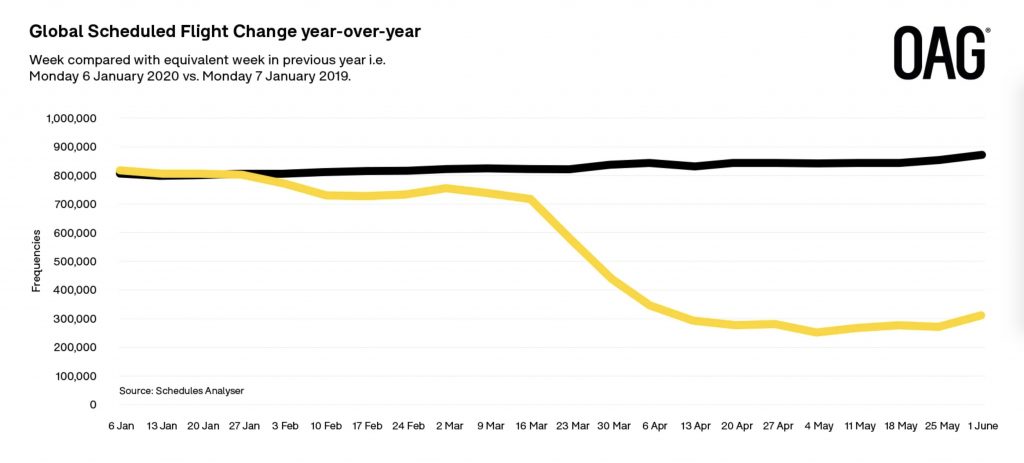Widely enforced lockdowns and flight restrictions are taking its toll on the global aviation industry.
The COVID-19 pandemic has gravely affected global aviation capacity, with governments enforcing trip cancellations and other flight restrictions as part of the efforts to slow down the spread of the coronavirus.
Since the beginning of this year, OAG Aviation Worldwide has been tracking the effect of the pandemic on the global flight capacity through the weekly inspection of scheduled flights and subsequently comparing it with last year’s figures. Their findings can be found in their regularly updated database.
Here are some key insights from their data.

Highlights
Globally, the number of scheduled flights for the week of June 1 is down by 65.1% compared to the figure recorded in the same week in 2019. In the table above, we can see equally drastic reductions in flight capacity the previous weeks.
On the whole, the number of scheduled flights seems to be increasing at a glacial pace, as evidenced by the slight upward direction of the curve in the graph above. This shows that the imposed restrictions are still keeping the aviation industry in a paralysed state.
This week, the largest decreases on the number of scheduled flights have been recorded in Singapore (- 96.1%), United Kingdom (- 93.6%), and Spain (-93.1%). Meanwhile, magnitudes of decline have been shrinking for China (- 19.8%), among the first countries to have attempted to reopen after months worth of lockdowns.
It is Europe which has experienced the most severe contractions in flight capacity over the past two months in spite of some European countries like France, Spain, Italy, and the UK already easing their lockdowns. This is because there remains a lot of caution towards air travel, especially international flights.
Some of the flight-related restrictions imposed by countries include country-specific flight suspensions, requiring returning citizens to enter through specific airports, mandatory screenings, two-week self-quarantine, and complete border closures.
The hardest hit
Singapore has recorded the biggest reductions in scheduled flights for several weeks now. OAG’s visualisation above shows just how devastating the impact COVID-19 has been on the country’s airline industry.
A few weeks back, we can remember how Singapore Airlines (SIA) recorded a historic loss of SGD 732 million in the three months leading to March 31, a stark contrast from the SGD 202 million profit recorded in the same period the previous year.
This resulted in a net loss for the fiscal year through March amounting to SGD 212 million, the first annual net loss in the 48-year history of the carrier.
“The deterioration in operating performance from January to March 2020 eroded the improvements made in the first nine months of the year,” according to SIA.
As countries begin to reopen, SIA said that the capacity will be continually adjusted in order to meet international travel demands. With this, SIA along with SilkAir has announced the reinstatement of flights in the following twelve cities: Adelaide, Amsterdam, Auckland, Barcelona, Brisbane, Cebu, Christchurch, Copenhagen, Hong Kong, Medan, Melbourne and Osaka for the month of June and July.
Previously, SIA CEO Goh Choon Phong said in a dialogue that the airline industry will remain competitive after COVID-19.
“Ours is a very highly competitive industry, as you are aware. How it will look like and how competitive it will really depend on a few factors. For example, which airlines manage to find liquidity to survive and emerge as stronger players after the crisis, how long the global economic recovery will take, and what changes we will see in terms of travel habits and value drivers of our customers.,” the SIA chief executive noted.












